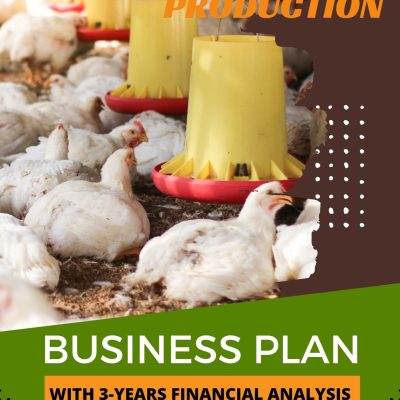Are you ready to embark on a journey of sustainable agricultural success? Look no further – our meticulously detailed Greenhouse Farming Business Plan is your gateway to thriving in the Nigerian and African markets. Designed to empower both seasoned farmers and ambitious newcomers, this comprehensive guide offers you unparalleled insights and strategies for cultivating tomatoes and bell peppers within state-of-the-art greenhouses.
Why Choose Our Greenhouse Farming Business Plan?
1. Tailored for Nigerian and African Markets: Crafted with a deep understanding of local agricultural dynamics, our plan is uniquely suited to the nuances of Nigerian and African farming environments.
2. Expertly Written: Our business plan is authored by agricultural experts with years of hands-on experience, ensuring you receive accurate, reliable, and actionable information.
3. Comprehensive Market Analysis: Gain a deep understanding of market trends, demand patterns, and consumer preferences, enabling you to make informed decisions for optimal profitability.
4. Detailed Financial Projections: Step confidently into the future with meticulously calculated financial projections that outline revenue, expenses, and profit potential over the next five years.
5. Strategic Production Plan: Harness the power of efficient cultivation strategies, crop rotation, and harvest schedules to maximize yields and ensure year-round production.
6. Innovative Sales Plan: Learn how to effectively position and market your produce, targeting key distribution channels and exploring export opportunities to widen your reach.
Your Path to Prosperity Starts Here
With our Greenhouse Farming Business Plan in your hands, you gain access to an invaluable resource that can transform your agricultural ambitions into thriving realities. Whether you’re an investor, entrepreneur, or agricultural enthusiast, this plan equips you with the tools you need to navigate the complexities of modern farming.
Join the Agricultural Revolution Today
Invest in your future and secure the success you’ve always dreamed of in the dynamic world of greenhouse farming. From seed to harvest, from the market to your balance sheet, our business plan guides you every step of the way.
Click ADD TO CART now to Get Your Copy!
Contents
I. Executive Summary ………………………………………………………………………. 6
A. Brief Overview of the Greenhouse Business Idea ………………………………….. 7
B. Mission Statement and Vision for the Business …………………………………….. 7
C. Key Objectives and Goals ………………………………………………………………. 7
D. Overview of Market Opportunity and Competitive Advantage …………………… 8
E. Financial Highlights and Funding Requirements: …………………………………… 8
II. Business Description …………………………………………………………………… 9
A. Introduction to the Greenhouse Business …………………………………………… 9
B. Location and Facilities …………………………………………………………………… 9
C. Target Market and Customer Analysis ……………………………………………… 10
Customer Analysis: ……………………………………………………………………… 10
Market Trends: ………………………………………………………………………….. 10
D. Product Offerings and Crop Selection ………………………………………………. 10
Crop Selection Rationale: ……………………………………………………………… 11
E. Overview of Sustainable Practices and Technologies ……………………………. 11
III. Market Analysis ……………………………………………………………………….. 13
A. Overview of the Agricultural Industry in Nigeria …………………………………. 13
Key Points: ……………………………………………………………………………….. 13
B. Market Size and Growth Potential for Greenhouse Products …………………… 13
1. Greenhouse Farming in Nigeria: ………………………………………………….. 13
2. Market Size for Greenhouse Products: …………………………………………… 14
3. Key Factors Driving Growth: ………………………………………………………. 15
4. Market Competitors: ………………………………………………………………… 15
C. Analysis of Customer Preferences and Demands: ……………………………….. 15
Customer Preferences for Tomatoes: ……………………………………………….. 16
Customer Preferences for Bell Peppers: …………………………………………….. 16
E. Market Entry and Growth Strategies ……………………………………………….. 16
Market Entry Strategies: ………………………………………………………………. 16
Growth Strategies: ……………………………………………………………………… 16
IV. Marketing and Sales Strategy ………………………………………………………. 17
A. Branding and Positioning of the Greenhouse Business ………………………….. 17
B. Pricing Strategy and Sales Approach ……………………………………………….. 17
C. Marketing Channels and Promotional Activities …………………………………… 17
D. Customer Retention and Expansion Strategies …………………………………… 18
E. Partnerships and Collaborations for Market Penetration ………………………… 18
V. Human Resources …………………………………………………………………….. 19
A. Organizational Structure and Key Roles ……………………………………………. 19
Organizational Structure: ……………………………………………………………… 19
5-Year Payroll ……………………………………………………………………………. 19
VI. Greenhouse Operations ……………………………………………………………… 20
A. Greenhouse Design and Layout ……………………………………………………… 20
1. Greenhouse Specifications: ………………………………………………………… 20
2. Greenhouse Features: ………………………………………………………………. 20
B. Crop Cultivation Techniques and Best Practices ………………………………….. 21
1. Crop Selection and Varieties: ……………………………………………………… 21
2. Propagation and Transplanting: …………………………………………………… 22
3. Nutrient Management: ……………………………………………………………… 22
4. Pruning and Training: ……………………………………………………………….. 22
5. Pollination: ……………………………………………………………………………. 22
6. Pest and Disease Control: ………………………………………………………….. 22
7. Harvesting and Post-Harvest Handling: …………………………………………. 22
VII. Yield and Sales Projection for Greenhouse Farm ……………………………….. 24
A. Yield projections ………………………………………………………………………… 24
Tomato ……………………………………………………………………………………. 24
Bell Pepper ……………………………………………………………………………….. 25
B. Sales Projection ………………………………………………………………………… 25
Assumptions: …………………………………………………………………………….. 26
VIII. Financial Projections ……………………………………………………………….. 27
A. Startup Costs ……………………………………………………………………………. 27
B. Sources of Funding …………………………………………………………………….. 28
C. Breakeven Analysis Year 1 ……………………………………………………………. 28
D. Costs Break-Down ……………………………………………………………………… 29
Tools and Equipment …………………………………………………………………… 29
Operational Expenses (Per Year, Naira): ……………………………………………. 29
Cost Of Goods Sold (COGS) …………………………………………………………… 30
E. PROFIT AND LOSS ASSUMPTION ……………………………………………………. 31
F. BALANCE SHEET PROJECTION ……………………………………………………….. 33
G. CASH FLOW PROJECTION …………………………………………………………….. 35
H. LOAN AMORTIZATION SCHEDULE ………………………………………………….. 36



